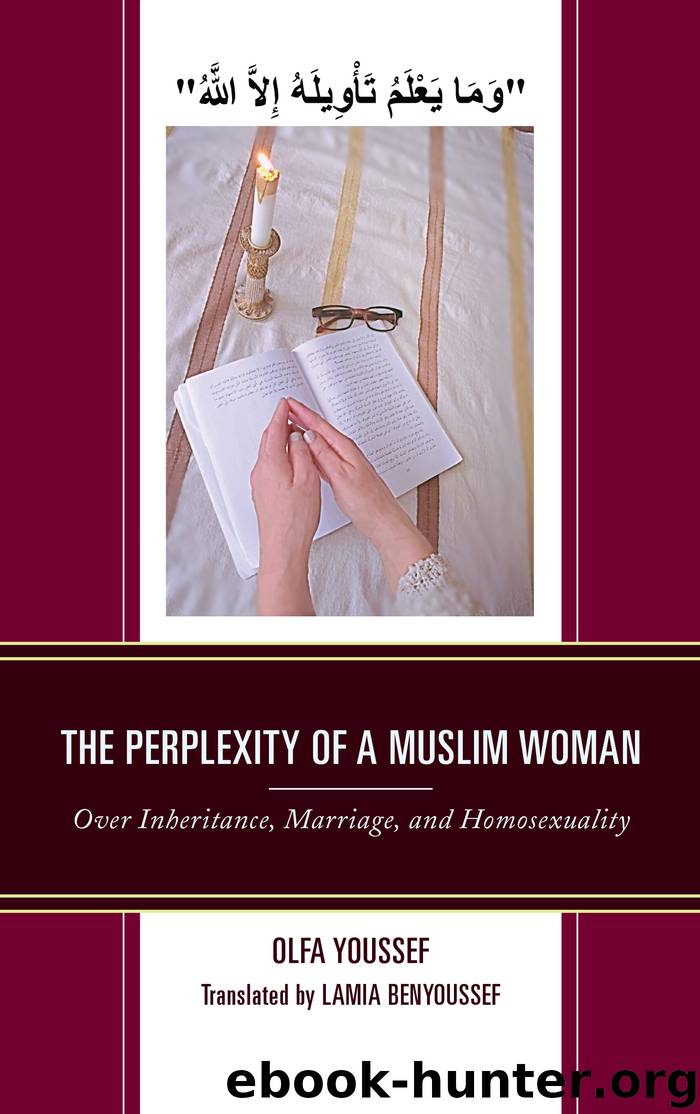The Perplexity of a Muslim Woman by Youssef Olfa; Benyoussef Lamia;

Author:Youssef, Olfa; Benyoussef, Lamia;
Language: eng
Format: epub
Tags: undefined
Publisher: Lexington Books
Published: 2012-04-09T04:00:00+00:00
Perplexity Seven: Polyandry and Polygamy
In the pre-Islamic Arabian Peninsula, taking multiple spouses was not exclusive to men, for it seems it was as common for men to take more than one wife as it was possible for women to take more than one spouse in one type of marriage known in Jāhiliyya as the marriage of al dhimād (الضّماد).[143] There was also another type of marriage called the marriage of Istibdhā’ (الاستبضاع). It consists of having the husband tell his woman after she had purified herself from menstruation, “Send for so and so and get pregnant from him.” The husband would then avoid his wife and not touch her until her pregnancy from that man she had sexual intercourse with shows. If the pregnancy is confirmed, the husband lies with her. It was for the purpose of giving birth to a son, that he would do that. It was also possible for a group of men, who are less than ten, to share one woman. If she gets pregnant and gives birth, she sends out for all of them—and none of them can decline—and tells them, “You know now the consequence of what you did. I gave birth. Here is your son, o, so and so,” and she would designate whoever she likes by name, so that he (the son) be affiliated with him.[144] Islam has apparently annulled all of these types of marriages according to the accounts transmitted by Aysha who asserts: “When Muhammad was sent out to preach righteousness, he destroyed all the marriages of al Jāhiliyya.”[145] In the Qur’an the only wedding or marriage that is allowed is the one based on Ihçān or protection, which requires, according to religious commentators, the existence of a dowry, vows and consent, two witnesses, and a legal guardian for the woman. As I explained the dowry is possible but not required in marriage. As for the witnesses, who are at least two, they are required because with them one distinguishes between marriage and “mukhādana” (المخادنة) cited in the Qur’an and which consists of taking a secret lover. As for vows and consent, these delineate the required approval of both sides. As for the guardian, there is a dispute over it among religious scholars, which denies it the quality of an absolute prerequisite.[146]
Nothing in the Qur’an prohibits the marriage of a woman with more than one man. Despite that, commentators, to justify their invalidation of the practice of having two male spouses share a woman, rely on the two verses in which the Almighty enumerates the women one is prohibited to marry and among them are married women.[147] What is problematic in the explicit statements of all commentators is their reliance on the one word “muhaçana” (محصنة). This word, indeed, denotes several meanings. According to commentators, the muhaçana refers to free and chaste women, polytheist women who have spouses, Muslim women who have spouses, and women in general. The context of the verse cannot denote the meaning of chastity because, for it is unimaginable that the Great and Almighty God would forbid marriage to chaste women.
Download
This site does not store any files on its server. We only index and link to content provided by other sites. Please contact the content providers to delete copyright contents if any and email us, we'll remove relevant links or contents immediately.
Cecilia; Or, Memoirs of an Heiress — Volume 1 by Fanny Burney(32436)
Cecilia; Or, Memoirs of an Heiress — Volume 2 by Fanny Burney(31872)
Cecilia; Or, Memoirs of an Heiress — Volume 3 by Fanny Burney(31857)
The Lost Art of Listening by Michael P. Nichols(7409)
Asking the Right Questions: A Guide to Critical Thinking by M. Neil Browne & Stuart M. Keeley(5646)
We Need to Talk by Celeste Headlee(5545)
On Writing A Memoir of the Craft by Stephen King(4863)
Dialogue by Robert McKee(4323)
Pre-Suasion: A Revolutionary Way to Influence and Persuade by Robert Cialdini(4151)
I Have Something to Say: Mastering the Art of Public Speaking in an Age of Disconnection by John Bowe(3842)
Elements of Style 2017 by Richard De A'Morelli(3307)
The Book of Human Emotions by Tiffany Watt Smith(3238)
Fluent Forever: How to Learn Any Language Fast and Never Forget It by Gabriel Wyner(3031)
Name Book, The: Over 10,000 Names--Their Meanings, Origins, and Spiritual Significance by Astoria Dorothy(2940)
Good Humor, Bad Taste: A Sociology of the Joke by Kuipers Giselinde(2904)
Why I Write by George Orwell(2875)
The Art Of Deception by Kevin Mitnick(2736)
The Grammaring Guide to English Grammar with Exercises by Péter Simon(2711)
Ancient Worlds by Michael Scott(2626)
